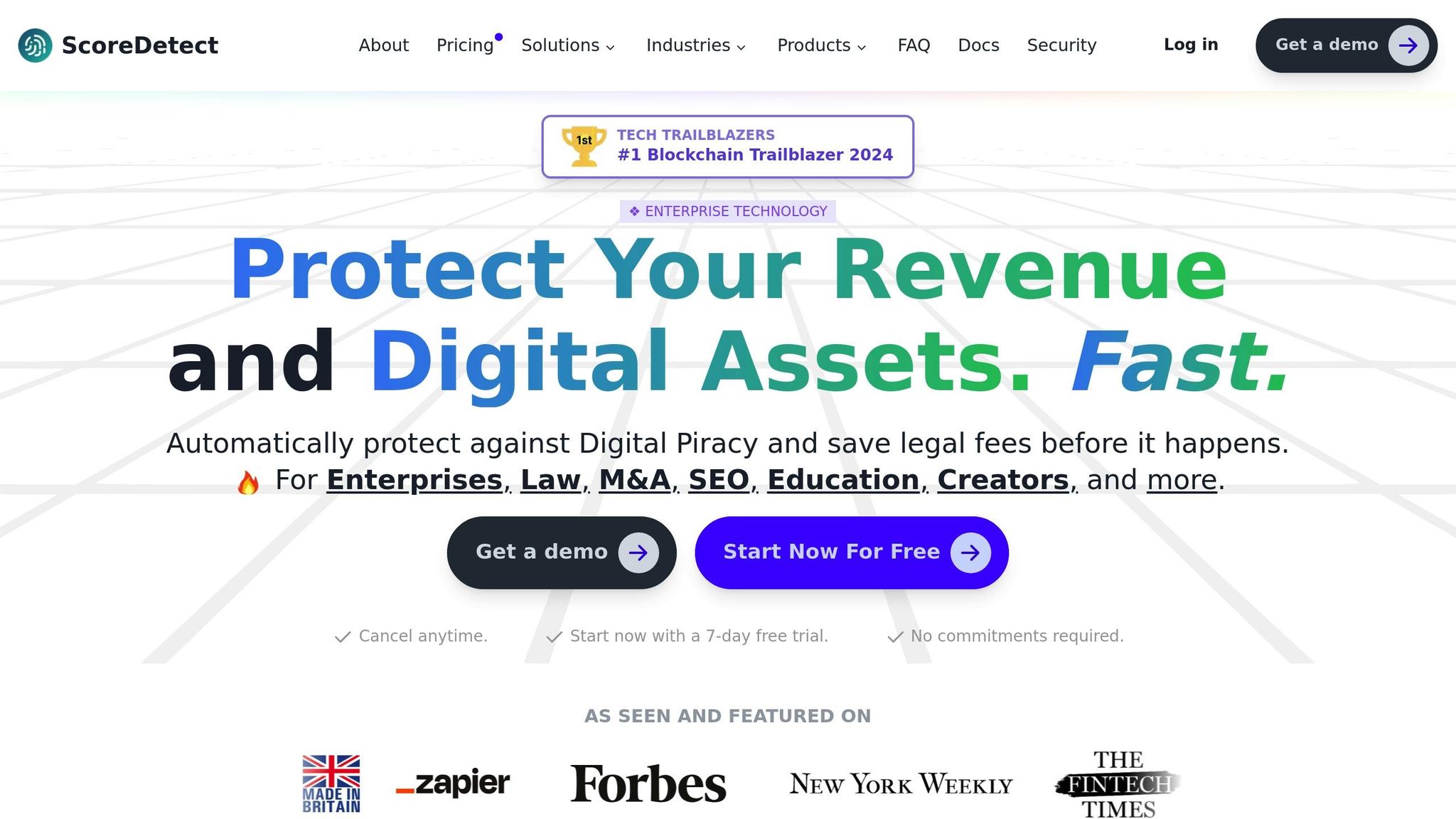Invisible watermarking is a powerful way to protect e-books from piracy. By embedding hidden identifiers into files, you can track, authenticate, and safeguard your content without affecting the reading experience. Here’s what you need to know:
- Why It Matters: E-book piracy caused a $315 million loss in the U.S. in 2022, with 33% of the market affected. Invisible watermarking helps prevent this by protecting copyright, identifying leaks, and enabling forensic analysis.
- How It Works: Techniques like binary embedding and code-level integration insert undetectable watermarks that survive file transformations like compression or cropping.
- File Formats: EPUB and PDF are ideal for watermarking, offering compatibility and functionality.
- Tools to Use: Platforms like ScoreDetect automate watermarking, track pirated files, and streamline takedown efforts with DMCA notices.
How eBook WaterMark works
Setting Up E-Books for Watermarking
Once you’ve grasped the benefits of invisible watermarking, the next step is configuring your e-books for the best protection. A well-executed setup ensures the watermark is both robust and easy to enforce later.
Compatible File Formats
When it comes to invisible watermarking, EPUB and PDF are the go-to file formats [4]. Each offers unique advantages suited to different needs:
Why Choose EPUB?
- Supports invisible watermarking seamlessly
- Works across a wide range of devices
- Maintains text functionality for readers
- Easily integrates with automated distribution systems
What Makes PDF Stand Out?
- Accommodates both visible and invisible watermarks
- Includes options for data encryption
- Preserves consistent layouts
- Handles complex formatting with ease
Metadata Setup for Tracking
Properly configured metadata is crucial for tracking and managing watermarked e-books. Here’s what to focus on:
- Essential Metadata Fields
Include key details like the title, author, contributors, series information (if applicable), publisher, ISBN, target audience, and intended marketplace. - Search Optimization
Select three to five BISAC codes [5] and include keywords that reflect:- Genre and subgenres
- Core themes
- Target demographics
- Relevant age groups
- Description Optimization
Craft a clear, searchable book description. Keep headlines concise – 25 words or 200 characters is ideal for better discoverability [5].
By aligning your file formats and metadata, you set the stage for effective watermarking while maintaining functionality.
Preserving Reading Quality
Watermarking should never come at the expense of the e-book’s quality. As William McLaughlin explains:
"The key to watermarking effectively is to treat the watermark as an integral part of the document rather than as something that can be added after the fact. A watermark that is ‘baked-in’ to the document rather than added as an object or layer will be substantially more difficult to modify or remove." [6]
To ensure the reading experience remains intact:
- Optimize file size during format conversions
- Retain full text functionality
- Test watermarked files on popular e-reader devices
- Regularly check that watermarked files match the original in quality
Invisible watermarking keeps the original file format intact, ensuring your e-books remain accessible across devices without the restrictions of DRM.
Adding Invisible Watermarks
The digital watermark market is expected to hit $97.58 million by 2031, highlighting the growing demand for effective invisible watermarking solutions [7].
Watermark Embedding Methods
Invisible watermarks rely on advanced techniques like steganography to embed traceable signatures into e-books. These subtle changes are undetectable to readers but offer robust tracking capabilities [3].
Binary Embedding subtly alters pixel values in the content to create a unique, traceable fingerprint:
- These changes are so tiny they don’t impact the reading experience.
- The embedded watermark remains intact even after typical file transformations.
- It’s designed to resist attempts at removal.
Code-Level Integration embeds watermarks directly into the structure of EPUB files through:
- Adjustments to HTML and CSS elements
- Modifications to metadata
- Encoding identifiers in file names
- Embedding dynamic user-specific identifiers
ScoreDetect Protection Setup

Here’s how to set up watermarking using ScoreDetect:
- Upload your e-book files to the ScoreDetect dashboard.
- Choose your desired watermarking parameters.
- Enable blockchain timestamping for an extra layer of security.
- Configure automated monitoring to keep track of your protected files.
Once configured, you can scale watermarking across your entire catalog with ease.
Processing Multiple E-Books
Batch Processing: ScoreDetect simplifies large-scale protection by processing files in batches. Each file takes about 3 seconds to process, ensuring efficiency without compromising quality.
Quality Assurance: To maintain high protection standards during batch processing:
- Run automated quality checks after watermarking.
- Verify file compatibility across various e-reader platforms.
- Confirm blockchain verification for all watermarked files.
- Test a selection of files to ensure the watermark is effective.
With human error contributing to 68% of data breaches [7], automating these processes ensures consistent protection and reduces risks. Once your watermarks are embedded and verified, the focus shifts to monitoring and enforcing your protection measures effectively.
sbb-itb-738ac1e
Tracking and Protection Enforcement
Digital watermarks play a key role in monitoring and safeguarding e-books from being distributed without permission. With a staggering 76% of popular textbooks found in pirated forms [8], having robust tracking and enforcement measures is essential to protect your intellectual property.
Finding Copied Content
ScoreDetect’s advanced web scanning technology works around the clock to identify unauthorized copies of your e-books online, even if the files have been altered or compressed. Here’s how it works:
- Forensic watermark tracking: Tracks pirated content effectively, even after modifications.
- Automated scanning: Monitors digital marketplaces and social platforms for illegal uploads.
- Blockchain verification: Confirms ownership in real time.
- Real-time alerts: Notifies you immediately when pirated copies are detected.
These tools allow for quick action to address unauthorized distribution.
Sending Takedown Notices
When pirated copies are discovered, ScoreDetect simplifies the process of removing them with automated DMCA notice generation. This system boasts a 96% success rate in getting content removed. Since most U.S.-based platforms comply with DMCA notices promptly to avoid legal issues [9], this process is streamlined and efficient. The automated system includes:
- Verifying copyright ownership using blockchain technology.
- Generating legally compliant DMCA notices.
- Submitting notices directly to hosting platforms.
- Tracking the status of takedown requests.
- Recording the outcomes of removal efforts.
Updating Security Measures
Detection and takedown efforts are only part of the solution – keeping your security measures up to date is equally important as piracy methods evolve. Yishi Shi, a digital watermarking expert from the University of Chinese Academy of Sciences, highlights the advantages of optical watermarking:
"In our research, we use a complex pattern of light, or diffraction pattern, as a unique watermark. Imperceptibility is one of the most significant advantages of optical watermarking." [2]
To maintain strong protection, it’s crucial to:
- Regularly monitor distribution channels for new threats.
- Update watermark patterns to stay ahead of circumvention techniques.
- Adjust tracking parameters based on emerging trends.
- Analyze attempts to bypass security measures.
- Enhance protection for content most at risk of piracy.
Conclusion
Digital piracy continues to pose a serious challenge, making strong protection measures an absolute necessity. One method gaining traction is invisible watermarking, which has proven to be an effective first line of defense against unauthorized content sharing.
ScoreDetect takes this a step further by combining advanced watermark embedding with robust metadata tracking, offering a comprehensive solution to safeguard your entire e-book collection. By integrating invisible watermarking with blockchain verification, the platform not only identifies unauthorized copies but also ensures their removal with impressive consistency.
"Digital watermarking is a potent tool for protecting intellectual property and copyrighted material." – Fortra’s Digital Guardian [1]
What sets ScoreDetect apart is its ability to provide persistent tracking capabilities through invisible watermarks that are undetectable to users. This ensures strong protection without disrupting the reader’s experience. Its automated system effectively prevents both deliberate piracy and accidental sharing, making it a valuable tool for publishers aiming for thorough content security.
With blockchain verification and automated alerts, ScoreDetect streamlines the entire process – from preventing piracy to enforcing protection. This integrated approach ensures e-books remain secure while maintaining their quality and accessibility. As digital publishing continues to evolve, ScoreDetect empowers publishers to stay ahead of emerging threats without compromising the reader experience or the integrity of their content.
FAQs
What makes invisible watermarking different from traditional DRM methods in protecting e-books?
Invisible watermarking and traditional DRM methods take different approaches to safeguarding e-books. Invisible watermarking is all about being subtle – it embeds hidden markers within the content, allowing publishers to trace unauthorized sharing without interfering with how users access or share the material. This method keeps the reading experience smooth and hassle-free.
On the other hand, DRM focuses on strict controls. It enforces rules on how users can access and use the content, offering stronger protection against piracy. However, these restrictions often come at the cost of user convenience, sometimes leading to frustration for those who legally purchase the content. Choosing between these methods depends on whether you prioritize tougher anti-piracy measures or a more seamless experience for your readers.
What challenges might arise when using invisible watermarking for e-books, and how can they be resolved?
Invisible watermarking in e-books comes with its own set of challenges. One major concern is the possibility of the watermark being removed or tampered with, especially if the technology used isn’t strong enough. Another issue arises when e-books are converted into different formats, which can strip away or weaken the embedded watermark, making it less effective.
To tackle these challenges, publishers can turn to advanced watermarking technologies that embed identifiers designed to be tough to remove. Combining watermarking with digital rights management (DRM) tools like encryption adds an extra layer of security. Additionally, keeping a close eye on illegal distribution and acting quickly to take down pirated copies can go a long way in protecting your content.
How can publishers keep invisible watermarks effective against advanced piracy methods?
To combat piracy effectively, publishers should adopt forensic watermarking. This technique embeds unique, tamper-resistant identifiers directly into e-books. These identifiers are designed to withstand common piracy methods, such as taking screenshots or converting files, making it possible to trace unauthorized copies back to their original source.
Another layer of protection comes from dynamic watermarking, which generates a unique watermark for each user or distribution instance. This approach makes it much more challenging for pirates to remove or alter the watermark without being detected. By regularly updating these watermarking techniques and pairing them with digital rights management (DRM) tools, publishers can build a strong defense against ever-evolving piracy tactics.

